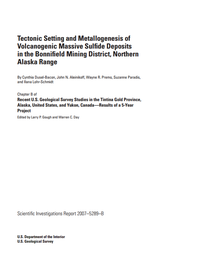This paper summarizes the results of field and laboratory investigations, including whole-rock geochemistry and
radiogenic isotopes, of outcrop and drill core samples from
volcanogenic massive sulfide (VMS) deposits and associated
metaigneous rocks in the Wood River area of the Bonnifield
mining district, northern Alaska Range (see fig. 1 of Editors’
Preface and Overview). U-Pb zircon igneous crystallization
ages from felsic rocks indicate a prolonged period of Late
Devonian to Early Mississippian (373±3 to 357±4 million
years before present, or Ma) magmatism. This magmatism
occurred in a basinal setting along the ancient Pacific margin
of North America. The siliceous and carbonaceous compositions of metasedimentary rocks, Precambrian model ages
based on U-Pb dating of zircon and neodymium ages, and
for some units, radiogenic neodymium isotopic compositions and whole-rock trace-element ratios similar to those of
continental crust are evidence for this setting. Red Mountain
(also known as Dry Creek) and WTF, two of the largest
VMS deposits, are hosted in peralkaline metarhyolite of the
Mystic Creek Member of the Totatlanika Schist. The Mystic
Creek Member is distinctive in having high concentrations of
high-field-strength elements (HFSE) and rare-earth elements
(REE), indicative of formation in a within-plate (extensional)
setting. Mystic Creek metarhyolite is associated with alkalic,
within-plate basalt of the Chute Creek Member; neodymium
isotopic data indicate an enriched mantle component for both
members of this bimodal (rhyolite-basalt) suite. Anderson
Mountain, the other significant VMS deposit, is hosted by
the Wood River assemblage. Metaigneous rocks in the Wood
River assemblage span a wide compositional range, including
andesitic rocks, which are characteristic of arc volcanism. Our
data suggest that the Mystic Creek Member likely formed in
an extensional, back-arc basin that was associated with an outboard continental-margin volcanic arc that included rocks of the Wood River assemblage. We suggest that elevated HFSE
and REE trace-element contents of metavolcanic rocks, whose
major-element composition may have been altered, are an
important prospecting tool for rocks of VMS deposit potential
in east-central Alaska.


